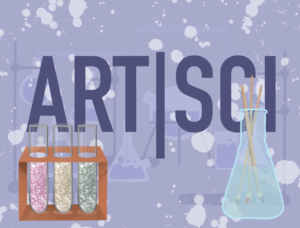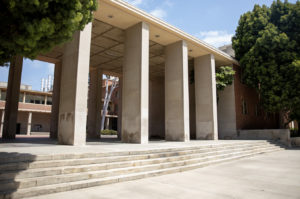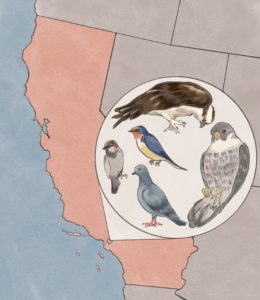This post was updated Nov. 7 at 9:02 p.m.
Counterforce Lab is combating environmental injustice in full force.
Formed by professor of design media arts Rebeca Méndez in 2015, the research studio works to tackle and build awareness around ecological issues, all while wielding the power of science and art. Focusing on reciprocal relationships, it stresses the importance of taking responsibility in a human-centric environment, Méndez said. Alumnus Ellie Diamant said Counterforce Lab fosters interspecies kinship by spearheading projects driven by ecological restoration.
“It’s a group of artists, thinkers, scientists, academics,” Diamant said. “The idea is to be this kind of counterforce to a lot of forces that we’re seeing in our society that are negatively affecting the environment and each other.”
Inspired by ecological artists Helen and Newton Harrison, Méndez said she resolved to create a team of her own. She said the goal of developing projects from nature’s perspective drew her to the intersection of art and science, with each discipline complementing the other. Diamant said Counterforce Lab stands out as an interdisciplinary haven, bringing people together to brainstorm grounded solutions. Where scientific thinking propels research-informed decisions, lecturer Yogan Muller said design addresses the visualization of such ideas, providing its strength of instant communication. The design of Counterforce Lab’s ventures are vehicles for storytelling, Méndez said, which is a key outlook of the organization.
[Related: Q&A: Nyambo Anuluoha talks up holding Yoruba traditions ahead of Fowler event]
The lab’s most recent project, the Biophilia Treehouse, is centered around building an ecosystem for birds in the midst of Los Angeles’ concrete jungle and is a manifestation of Counterforce Lab’s mission, Méndez said. By building a series of treehouses in areas with dwindling bird populations, Méndez said the lab hopes to create a wildlife corridor and curb environmental inequities.
Tethered to her home during the COVID-19 pandemic, Méndez’s global research turned local. An avian enthusiast, she said she saw firsthand the plight of diseased birds migrating to greener spaces. Birds are indicator species and their well-being alludes to the overall health of the environment, making them critical to measuring ecological welfare, she said. By prioritizing birds, Méndez said Counterforce Lab aims to deconstruct the human hierarchy in the environment and promote an appreciation for nonhuman beings.
“Even in the moments where the world is very difficult, you need to rage with love,” Méndez said. “We need to actually transform some of our sense of paralysis of the climate crisis and the future with a sense of incredible love and empathy for all living beings.”
The treehouse consists of three layers, with each fulfilling a different purpose, Méndez said. The ground level serves as a space for human habitation, often utilized as a meditative or educational site, she said. Moving up, Méndez said each succeeding layer is a temple for birds, with ground foragers and grass nesters finding their homes in the lowest levels and cavity nesters inhabiting the highest.
Constructed with eco-friendly elements, the treehouse is augmented with flowing water and native flora and fauna – all to ensure the well-being of urban bird species, Méndez said. An inversion of a human home, she said the bulk of the structure’s architecture is informed by bird behavior. Associate director Diamant added that the treehouse caters to a reciprocal relationship between humans and birds and facilitates multispecies friendships.
Using mapping, the team found that areas with sparse tree canopy, dense human populations, lack of access to a park and underserved communities overlapped, Muller said. By targeting these regions, Counterforce Lab works to create a stepping stone for birds to heal their fragmented ecological habitat, Méndez said. With that in mind, Muller said the lab resolved to place treehouses along these intersections by fostering community collaborations at each site.
[Related: Ebb & Flow festival dances for environmental action at Ballona Creek]
Beyond restoring avian welfare, Méndez said the treehouse is a manifestation of the relationship between the land and the community it resides in. For instance, Méndez said their partnerships with educational organizations such as Heart of Los Angeles, which aims to circulate after-school education to children in underserved communities, could transform the treehouse’s ground level into an outdoor classroom. Environmental injustice begets inequity, Méndez said, and lack of access to green spaces is closely linked to underprivileged habitations. Structures made with community collaboration would break this vicious cycle, Méndez said.
To augment the outdoor educational zones, the lab also developed curriculums centered around environmental knowledge, Méndez said. In light of the growing need for ecological activism, Méndez said environmental education should not be dismissed in order to propagate attitudes of responsibility for the Earth’s well-being. By bringing it to the forefront in the presence of the treehouse structure, Méndez said young minds can connect to the natural world and become stewards of the environment in their own right. Storytelling, both through workshops and the design itself, is crucial as it positions communities in the minds of other species and enables personal change, Méndez added.
“I do believe that storytelling is a way to bring us all together, from the sciences to Indigenous histories and stories from time immemorial, from multiple cultures that bring so much wisdom,” Méndez said. “It is through story that we will be able to then arrive at a place where we engage with the world, with our heart and with our soul, and then we are compelled to do something.”
Through its work, Counterforce Lab hopes to initiate a fundamental shift in how humans view their place in the natural world, Méndez said. By realizing the interwoven web of ecology that stems beyond humans, Diamant said members can foster a sense of curiosity toward the environmental crisis. The lab wishes to replace hierarchical consumer attitudes with a love and appreciation for all living things – a goal that will remain relevant even in a rapidly changing world, Méndez said.
“Where Counterforce Lab is going is definitely in this decentering (of) the human point of view, … entering into interspecies kinship, considering indigenous voices and, especially, these decolonial practices,” Méndez said. “We are lean, and we’re always responsive to what goes on in the world. That’s why I say the Counterforce Lab is a lab focused on change.”





Comments are closed.